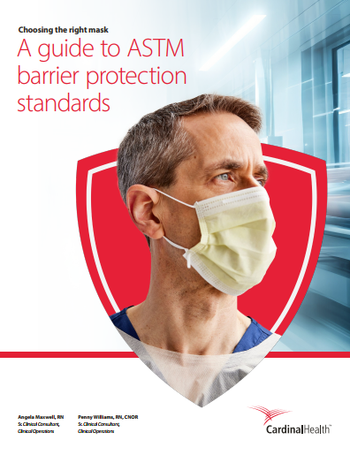
Reliability in Just the Right Size: A Q&A With Expert Rosemary Sergakis, DNP, RN, NE-BC, EBP (CH), About the Guardian 800 mL Canister
Sponsored by Cardinal Health.
ROSEMARY SERGAKIS, DNP, RN, NE-BC, EBP (CH)
GLOBAL MEDICAL SCIENCE LEAD
CARDINAL HEALTH
SAN ANTONIO, TX
Infection Control Today® (ICT®) recently spoke with Rosemary Sergakis, Global Medical Science Lead at Cardinal Health, about the 800 mL Guardian canister as a line extension, helping address clinician concerns and customer fluid collection needs with a single sup- plier. She serves as an excellent resource for today’s market, providing executive leadership with ways to strengthen their clinical education programming and organizational behavior and achieve corporate initiatives. She received her doctorate in nursing practice at The Ohio State University in Columbus and worked at Level 1 trauma hospitals prior to her work as a clinical consultant and medical science lead. Sergakis regularly volun- teers with the Medical Reserve Corps, Wildlife Rescue and Rehabilitation, and she serves on the women’s board for the local botanical garden and conservatory.
ICT: Why should facilities add a smaller canister size to their fluid management portfolio?
SERGAKIS: Fluid management products assist in the removal, collection, and disposal of bodily fluids and debris all around hospitals, ambulatory surgery centers [ASCs], and doctors’ offices. Stocking the right-sized canister in the patient room for a surgical procedure [or] on a crash cart or anesthesia cart is worth talking about. Fluid management canisters are used perioperatively, postoperatively, and at the patient bedside, with the level of fluid collection requirements varying dramatically depending on the patient, the surgery, or the emergency. Meeting the fluid containment requirements by using the correct-sized canister may provide cost savings [and] space savings and may help make a difference toward environmental issues.
ICT: What issues are top of mind for clinicians, and how does the product address these?
SERGAKIS: Storage in health care facilities can be limited; every square meter used for product storage must be carefully considered. The Guardian 800 mL canister is stackable for easy storage, and the smaller canister size requires less storage than the larger canister offerings, resulting in space savings. In addition, the Guardian canister line requires minimal hardware.
Cost savings may be realized byusing the right-sized product to matchthe medical procedure. The Joint Commission guidelines state [that]suction and a canister need to be pres-ent to address emergency situations.An 800 mL canister on a crash cart,anesthesia cart, or in patient rooms/bays may be a viable option [ratherthan] using larger-volume canisterscurrently in those locations.
Sustainability is also top of mind in many industries today, especially health care. By utilizing a smaller canister size when applicable, the environmental foot- print can be reduced in both manufactur- ing and waste to landfill.
With increasing cost pressures in today’s economy, 2022 was one of the most financially challenging years for hospitals since the [COVID-19] pandemic. Supply chain disruptions have resulted in more costly manufacturing, packag- ing, and shipping, causing higher prices for hospitals when purchasing medical products (Costs of Caring | AHA). It is crucial for facilities to take advantage of opportunities for cost reduction. With the same reliability of the larger Guardian canister offerings, this 800 mL size provides potential cost-savings for facilities, both in price as well as waste-disposal costs. It can cost up to $0.50/lb to dispose of regulated medical waste (Part 1: Are You Throwing Away Money with Your Waste Removal Practices? | Red Bag Solutions). With a smaller canister, the weight following fluid collection will be smaller than the larger canisters and can possibly result in reduced disposal costs per pound.
Lastly, sourcing products from a single supplier can be more cost-effective for facilities, among other benefits. By offering a broader fluid management portfolio inclusive of the 800 mL canister, customers can purchase their entire port- folio of fluid management solutions from [a] single supplier. This can help with cost savings, consistency in allocation and acquisition of supply, and stronger relationships between supplier and customer.
ICT: What issues do clinicians face in the fluid management space?
SERGAKIS: An issue faced by clinicians in the fluid management space is [that] the current offerings are too large for clinical needs. Certain areas within a hospital, such as patient bedside, mobile crash carts, and anesthesia carts, require fluid collection devices, but canisters are often too large for the volume collection in these spaces. In addition, so do pediatric facilities as well as ambulatory surgery centers with low fluid volume procedures, such as plastics, otolaryngology (ENT), obstetrics and gynecology (OB/GYN), and dental. By offering a smaller canister size, the needs of these spaces and procedures are better met with a solution requiring minimal hardware or practice change.
ICT: Looking at trends in the health care market, we are seeing a large shift to ASCs. What are some important considerations with this shift, and how can the product address these?
SERGAKIS: ASCs have a market share valued at USD
36.8 billion in 2022 and is anticipated to grow a compound annual growth rate (CAGR) of 6% from 2023 to 2030 [U.S. Ambulatory Surgery Centers Market Size, Share & Trends Analysis Report By Specialty]. Many procedure types conducted in the ASC space are low volume and require less than 800 mL [of] fluid per procedure. These procedure types include plastics, ENT, OB/GYN, and dental [100 things to know about ASCs | 2020 (beckersasc.com)]. With the continued growth in the ASC space and the need for smaller-volume collection options, the 800 mL canister provides an optimal solution for this market.
ICT: What is the benefit of customers standardizing to a single supplier?
SERGAKIS: A benefit of customers standardizing to a single supplier is cost savings in terms of administrative costs and maximum volume for better pricing. Another benefit is consistency of supply (allocation, prioritization, visibility, and monitoring of entire portfolio). It offers the opportunity for more efficient communication; stronger relationships between Cardinal Health, the sales representative, and the customer; as well as high-quality products and services.
To learn more about Cardinal Health’s 800 mL canister and full suite of fluid management solutions, visit cardinalhealth.com/fluid-management.
Newsletter
Stay prepared and protected with Infection Control Today's newsletter, delivering essential updates, best practices, and expert insights for infection preventionists.





